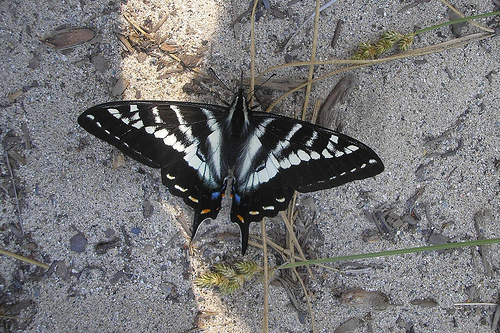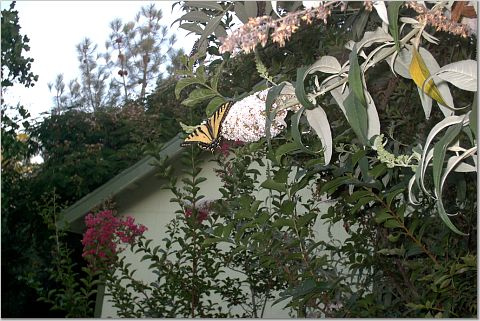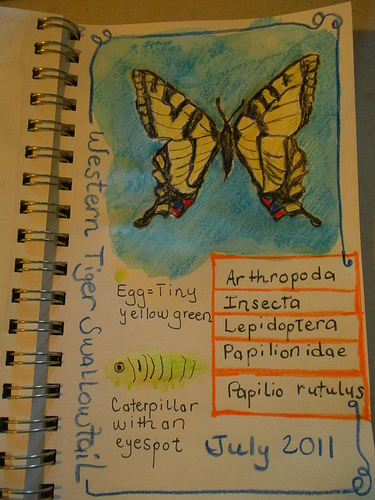 |
| Swallowtail at Yosemite National Park 2006 |
Since we just studied and observed our honeybees, we decided to learn more about another common backyard insect that we see all the time in our butterfly garden….the Western tiger swallowtail. There are some amazing images on this webpage. There is also quite a bit of information on Enchanted Learning.
 |
| We often see swallowtails on our butterfly bushes. |
This rather large butterfly is a frequent visitor to our backyard habitat. One afternoon this past week I watched as two swallowtails dipped and swirled around the garden. They are so pretty but they don’t stay put very long at all.
We pulled out the Handbook of Nature Study and read the section on Black swallowtail butterflies to get sort of an overview of this insect. (Lesson 70) Here is a little excerpt:
“This graceful butterfly is a very good friend to the flowers, being a most efficient pollen-carrier. It haunts the gardens and sips nectar from all the blossom cups held out for its refreshment; and it is found throughout almost all parts of the United States. The grace of its appearance is much enhanced by the “swallowtails,” two projections from the hind margins of the hind wings.” Handbook of Nature Study, page 301
We got out our insect field guide and found out some more interesting facts:
Its caterpillars feed on alder, poplar, willow.
Habitat: Mixed and deciduous forests, open ares, even in urban areas.
Wingspan 3 1/2″ to 4 3/8″
Yellow wings, single “tail”
This Saturday, July 16th, is the day that the Great Sunflower Project is requesting that we observe our bees. Read more about how you can participate HERE. I look forward to hearing about your bees as part of the July Newsletter challenge. You can also observe your sunflowers at the same time!


I love your photos (gorgeous shot at Yosemite!), that excerpt from the HNS about the butterflies being ‘a most efficient pollen-carrier’ and your beautiful journal entry! Excited about the bee count! Interested to see our results because we had many more sunflowers last year and only a few this year due to lack of rain.
I really love seeing your journal pages and how you use the techniques described.
Would you happen to know the variety of butterfly bush that you captured in the photo? I would really like to grow one, but all I have found have been the petite series…more shrublike, attaining a height of 3-4 feet. Thanks!
Beautiful photos, and journal. We see a lot of black swallowtails here, as well as others. Some of my photos of them are used in this slideshow — thought you might find it interesting: http://www.learnnc.org/lp/editions/butterflyworld/ — Best, Kathy at http://www.needleandspade.com
Our butterfly bush didn’t make it through the winter for some reason, but we are still seeing lots of pretty Western swallowtails here! At least, I think that’s what they are–as you say, they won’t stay put so it’s hard to get a good look!
dneesi,
The butterfly bushes we have in the backyard have been there so long that I don’t remember the variety. If I think of it, I will include it in a future post.
Barb